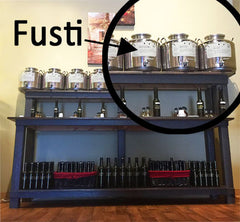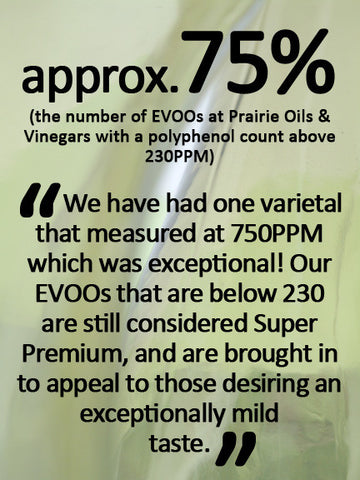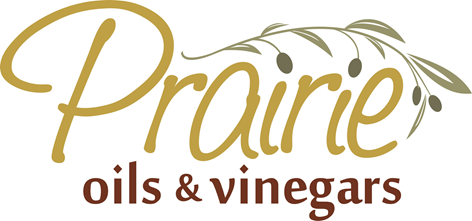EVOO Definitions
At Prairie Oils & Vinegars, our Extra Virgin Olive Oils are always sent to an independent food laboratory to be tested. The purpose behind this is not just to provide us with backing to provide customers with the knowledge that our EVOOs have never been cut with any other oils, and that they are indeed cold-pressed, one time, and of the highest possible quality. Another reason why we do this is to isolate the exact make-up of these EVOOs, so that we can see that they are high quality, providing good health benefits, and see what makes them taste the way they do.
This chemical analysis is always provided for you on every selected EVOO in our store, along with the Paul Vossen taste analysis - right on the front of each shining fusti!
 What's a Fusti? It's a container, vat, barrel, or jug, specially made out of stainless steal to store oils, wine, vinegar, honey, or other liquids. Stainless steal fustis, when closed, keep out any light and air, to ensure the product inside is kept as fresh as possible. Prairie Oils has approximately 50 fustis out on the shelves at any given time.
What's a Fusti? It's a container, vat, barrel, or jug, specially made out of stainless steal to store oils, wine, vinegar, honey, or other liquids. Stainless steal fustis, when closed, keep out any light and air, to ensure the product inside is kept as fresh as possible. Prairie Oils has approximately 50 fustis out on the shelves at any given time.
And here are some other definitions for terms you will find used in our store, and in our chemical analysis in particular.
Chemistry Definitions
Oleic Acid - Oleic Acid is a monounsaturated omega-9 fatty acid found in olive oil. Olive oil is generally higher in oleic acid than other vegetable fats. The range found in Extra Virgin Olive Oils is between 55-83%. Extra Virgin Olive Oil high in oleic acid has a greater resistance to oxidation. Our average is 77%.
FFA - Stands for Free Fatty Acids. Free fatty acid speaks to the condition of the fruit at the time of crush. The higher the FFA the greater the indication of poor quality fruit such as damaged, overripe, insect infested, overheating during production or too much of a delay between harvest and crush. Based on International Olive Oil Council (IOOC) standards, the maximum limit for free fatty acid in Extra Virgin Olive Oil is 0.8%. Our average is 0.18!
Peroxide Value - Unsaturated free fatty acids react with oxygen and form peroxides, which create a series of chain reactions that generate volatile substances responsible for typical musty/rancid oil smell. These reactions are accelerated by high temperature, light and oxygen exposure. A very low peroxide value is desirable. Based on IOOC standards the maximum peroxide value for Extra Virgin Olive Oil is 20. Our average is 3.2!
 Polyphenols - Polyphenols are a class of antioxidants found in a variety of foods. Recent studies indicate that these potent phenols are responsible for many of the health benefits associated with consuming fresh, high quality Extra Virgin Olive Oil. Phenols in olive oil decrease over time or when exposed to heat, oxygen and light. Consuming fresh, well made Extra Virgin Olive Oil with high polyphenol content is crucial when looking to obtain the maximum heath benefits commonly associated consuming extra virgin olive oils. Polyphenols such as Oleuropein, Oleocanthal, and Hydrooxytyrosol also impart intensity connected with pepper, bitterness and other desirable flavour characteristics. Polyphenol counts are measured in Parts Per Million (PPM). Polyphenol counts of 230PPM or higher are considered EXTREMELY high in healthy antioxidants.
Polyphenols - Polyphenols are a class of antioxidants found in a variety of foods. Recent studies indicate that these potent phenols are responsible for many of the health benefits associated with consuming fresh, high quality Extra Virgin Olive Oil. Phenols in olive oil decrease over time or when exposed to heat, oxygen and light. Consuming fresh, well made Extra Virgin Olive Oil with high polyphenol content is crucial when looking to obtain the maximum heath benefits commonly associated consuming extra virgin olive oils. Polyphenols such as Oleuropein, Oleocanthal, and Hydrooxytyrosol also impart intensity connected with pepper, bitterness and other desirable flavour characteristics. Polyphenol counts are measured in Parts Per Million (PPM). Polyphenol counts of 230PPM or higher are considered EXTREMELY high in healthy antioxidants.
Oleuropein - A type of polyphenol that has been linked to several pharmacological effects among them the strengthening of the immune system.
Oleocanthal - A type of polyphenol that has been found to be have anti-inflammatory and antioxidant properties. It is suggested that long-term consumption of small quantities of oleocanthal from extra virgin olive oil may be responsible in part for the low incidence of heart disease associated with a Mediterranean diet. It has been demonstrated that oleocanthal shows potential as a therapeutic weapon for the treatment of inflammatory degenerative joint diseases.
Hydrooxytyrosol - A type of polyphenol that is believed to be one of the most powerful antioxidants. Its oxygen radical absorbance capacity is ten times higher than that of green tea. Hydrooxytyrosol is used for medical purposes, including its immunostimulant and antibiotic properties which stimulate the immune system and kill or slow down the growth of bacteria.
DAGs Test/Score - Measures the proportion of two forms of diacylglycerol: 1,2 and 1,3. In oil freshly made from sound olives of good quality, the prevalent form of DAG is the 1,2 form where the fatty acids are bonded to a glycerol molecule in the 1 and 2 positions. The bond on the 2 position is weak and easily broken, leading to the migration of that 2 position fatty acid to the 3 position. This results in the much more stable 1,3 DAG. This makes the ration of 1,2 DAGs to the total DAG’s a good indicator of the quality of the olive fruit and the processing. It is also an indicator of the age of an oil, since the migration from 1,2 to 1,3 DAGs takes place naturally as the oil ages. Warmer storage temperatures, and higher free fatty acid levels will both accelerate this process, but DAGs are not affected by the short exposure to high heat that is characteristic of deodorizing (refining).
PPP Test/Score - This test was developed to measure the degradation of chlorophyll in olive oil. This degradation of chlorophylls to pyropheophytin was found to take place at a predictable pace, making it possible to gain information about the age of an olive oil. The rate at which the degradation occurs can be accelerated by even short periods of high temperatures – such as that which is utilized during the deodorizing or soft column refining process – making it a useful indicator of the presence of deodorized olive oil as well as the age of the oil.
